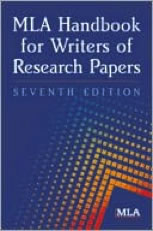Introduction

Source: MLA Handbook, Modern
Language Association of America,
Wikimedia Commons
So you’ve come up with an interesting research topic, found supporting information from a variety of sources, organized that information, and written the first draft of your research paper. You’ve completed most of the work of the research process, right? The answer is a resounding no. Unless you have collected important information about each source as you were taking notes, documented the sources you used within the text of your paper, and then made a list of the works you cited, you are not ready to move on. As a matter of fact, if you haven’t documented your sources correctly, you might be suspected of either deliberate or unintentional plagiarism. (Yikes! You don’t want to be in that situation.) We’re still talking about your first draft, so there would be time to fix the problem. But it’s easier to take care of your documentation responsibilities at the beginning of the research process than to scramble to fill in details shortly before the paper is due.
The MLA Handbook for Writers of Research Papers, commonly called the MLA Handbook, is the style guide we’ll focus on using because most English and humanities courses use it. If you follow the guidelines in the MLA Handbook, you will gain
- consistency in the way you format pages and identify sources;
- evidence that you have used others’ work to supplement and support your work;
- protection from accusations of plagiarism; and
- credibility as a writer.
Documentation is not difficult, but it is detailed. If you’re someone who dislikes doing detailed work, we’ll wait while you take a deep breath, put a big smile on your face, and repeat to yourself, “Documenting is easy; documenting is easy.” Ready? Let’s get started.

Source: Smiling face on blackboard, aluxum, istockphotos